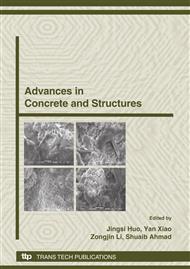p.433
p.441
p.447
p.453
p.459
p.465
p.471
p.477
p.483
Preliminary Study on a New Evaluation Method of Concrete Cracking Resistant Behavior
Abstract:
A restrained ring setup with a clapboard was developed. Because the clapboard can cause a stress concentration of concrete annulus placed in the ring setup, a crack of the concrete annulus can rise at the tip of the clapboard at an early age of curing. Then the time-span of the evaluation of concrete cracking behavior is shortened. The new evaluation method can avoid the disadvantages of applying the conventinal restrained ring setup without a clapboard when evaluating the cracking resistant behavior of concrete, such as the longer time-span, randomicity and chanciness of concrete cracking. Based on experimental data, in which the effect of polypropylene fiber and expansive agent on the cracking resistant behavior of concrete was investigated, the cracking age of concrete loops and the ratio of tensile strength to compressive strength of concrete were obtained, and the validity of the proposed ring setup has been verified.
Info:
Periodical:
Pages:
459-463
Citation:
Online since:
October 2008
Authors:
Price:
Сopyright:
© 2009 Trans Tech Publications Ltd. All Rights Reserved
Share:
Citation:


